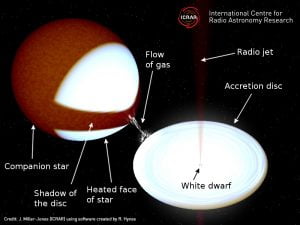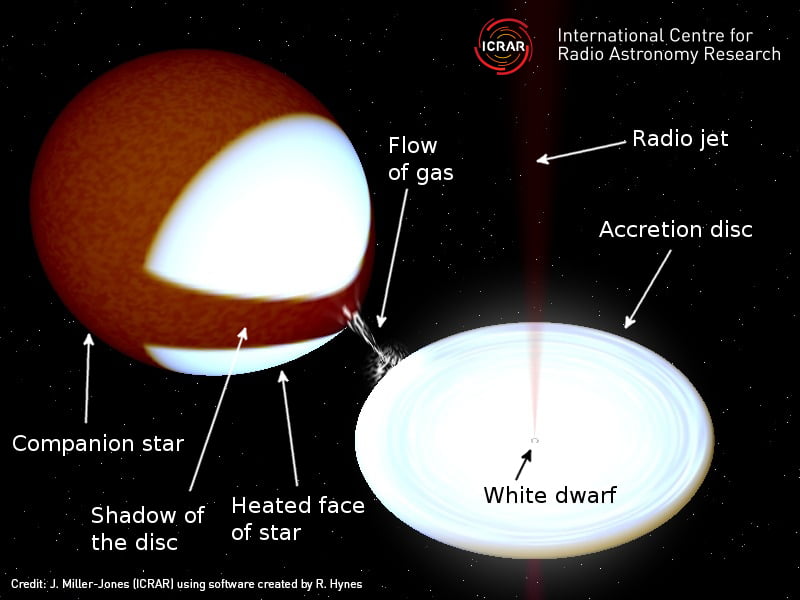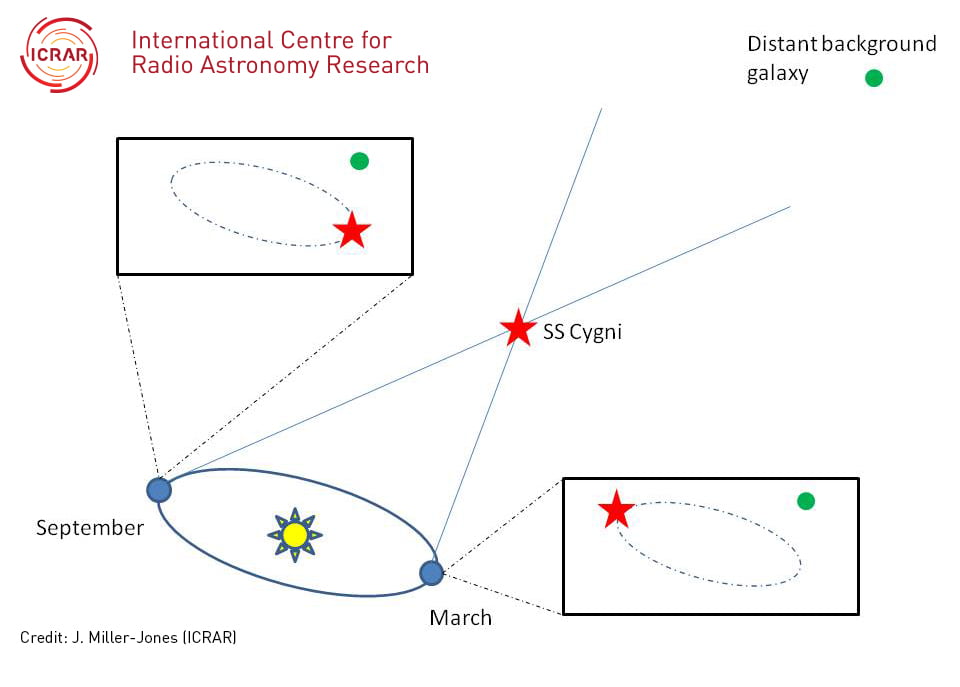
Schematic diagram of the white dwarf binary system SS Cygni. The two stars are close enough to one another that gas falls in from the companion star and swirls around the white dwarf in an accretion disc. The disc gets very hot, producing radiation that illuminates the surface of the companion star and heats it up. Gas from the inner part of the disc is accelerated outwards in fast-moving, oppositely-directed jets, which produce the radio waves that the astronomers used to study the star system and measure its distance from Earth. Image credit: J. Miller-Jones (ICRAR), using software created by R. Hynes.
An extremely precise measurement of the distance to a star system has finally allowed astronomers to solve a decade-old puzzle, confirming understanding of the way exotic objects like black holes interact with nearby stars.
Published today in prestigious journal Science, a team of astronomers headed by Dr James Miller-Jones from the Curtin University node of the International Centre for Radio Astronomy Research (ICRAR), have measured the distance to star system SS Cygni to be 372 light years, much closer than a previous measurement made by the Hubble Space Telescope in the 1990s.
The measurement was made possible by amateur astronomers from the American Association of Variable Star Observers (AAVSO) who alerted the team to changes in the compact star system, triggering the team to start observations with two of the world’s most accurate radio telescopes.
Dr Miller-Jones’ team then measured the annual wobble of the system compared to distant background galaxies, allowing them to measure the distance to SS Cygni with unprecedented precision
“If you hold your finger out at arm’s length and move your head from side to side, you should see your finger appear to wobble against the background. If you move your finger closer to your head, you’ll see it starts to wobble more. We did the exact same thing with SS Cygni – we measured how far it moved against some very distant galaxies as the Earth moved around the Sun,” Dr James Miller-Jones said.
“The wobble we were detecting is the equivalent of trying to see someone stand up in New York from as far as away as Sydney.”
The distance to SS Cygni had previously been measured using the Hubble Space Telescope, producing a puzzling result that was much further than predicted.
“If SS Cygni was actually as far away as Hubble measured then it was far too bright to be what we thought it was, and we would have had to rethink the physics of how systems like this worked,” Dr Miller-Jones said.
Dr Miller-Jones said that SS Cygni is a double star system containing a normal low mass star and a white dwarf star.
A white dwarf is the remnant of a star like our Sun that has run out of fuel and collapsed into an object about the size of Earth. Because it’s so dense, its strong gravity strips gas off its companion star, which then swirls around the white dwarf.
Occasionally the flow of gas onto the white dwarf will increase dramatically, causing the system to appear up to 40 times brighter in visible light. It’s only during these rare periods that the star system emits radio waves, which allow for a much more precise measure of the distance.
“Our key advantage was using radio telescopes to observe the system. In visible light, optical telescopes like Hubble see hundreds of different stars, all of which are moving by different amounts, whereas in radio waves the background we compare against is much further away and therefore doesn’t appear to move at all,” co-author Assistant Professor Gregory Sivakoff from the University of Alberta, said.
The team used groups of telescopes called the Very Long Baseline Array (VLBA) in the United States and the European Very Long Baseline Interferometry Network (EVN) in Europe and South Africa to pinpoint the exact location of the system relative to the background galaxies.
“The system only emits radio waves for a short period of time. Without the cooperation of our many amateur observers who looked at SS Cygni night after night, we wouldn’t have known when to look – their contribution was invaluable,” co-author Dr Matthew Templeton from the AAVSO said.
The measured distance of just over 370 light years means the light detected by the team left SS Cygni around the time that famous physicist Sir Isaac Newton was born in the 1600s.
“The pull of gas off a nearby star onto the white dwarf in SS Cygni is the same process that happens when neutron stars and black holes are orbiting with a nearby companion, so a lot of effort has gone in to understanding how this works,” Dr Miller-Jones said.
“Our new distance measurement has solved the puzzle of SS Cygni’s brightness, it fits our theories after all.”
ICRAR is a joint venture between Curtin University and The University of Western Australia providing research excellence in the field of radio astronomy.
Contacts:
Dr James Miller-Jones
ICRAR, Curtin University
M: +61 488 484825
E: james.miller-jones@icrar.org
Assistant Professor Gregory Sivakoff
University of Alberta
P: +1 780 492 7992
E: sivakoff@ualberta.ca
Dr Matthew Templeton
American Association of Variable Star Observers (AAVSO)
P: +1-617-354-0484
E: matthewt@aavso.org
Kirsten Gottschalk
Media Contact, ICRAR
M: +61 438 361 876
E: kirsten.gottschalk@icrar.org
Megan Meates
Media Contact, Curtin University
Ph: +61 8 9266 4241
M: +61 401 103 755
E: megan.meates@curtin.edu.au
Multimedia

Schematic diagram of the white dwarf binary system SS Cygni. The two stars are close enough to one another that gas falls in from the companion star and swirls around the white dwarf in an accretion disc. The disc gets very hot, producing radiation that illuminates the surface of the companion star and heats it up. Gas from the inner part of the disc is accelerated outwards in fast-moving, oppositely-directed jets, which produce the radio waves that the astronomers used to study the star system and measure its distance from Earth. Image credit: J. Miller-Jones (ICRAR), using software created by R. Hynes.
An animation of the orbit of the white dwarf binary star system SS Cygni. The white dwarf and its companion star are separated by just under a million miles, and orbit each other once every six and a half hours. The strong gravity of the white dwarf distorts the companion star, so that gas from the star falls in towards the white dwarf via an accretion disc. The disc gets so hot that it heats the facing surface of the companion star. Fast-moving jets are launched from the central parts of the disc and give off radio waves. Astronomers used these radio waves to measure the distance to the star system as 372 light years from Earth. Credit: J. Miller-Jones (ICRAR), using software created by R. Hynes.

Measuring the distance to SS Cygni using the parallax technique. As the Earth orbits the Sun, SS Cygni appears to move back and forth relative to the position of a distant background galaxy, which is so far away that it stays stationary on the sky. The size of the apparent “wobble” of SS Cygni gives a direct measure of the distance; the further away SS Cygni is from Earth, the smaller the wobble.
Image credit: J. Miller-Jones (ICRAR)

